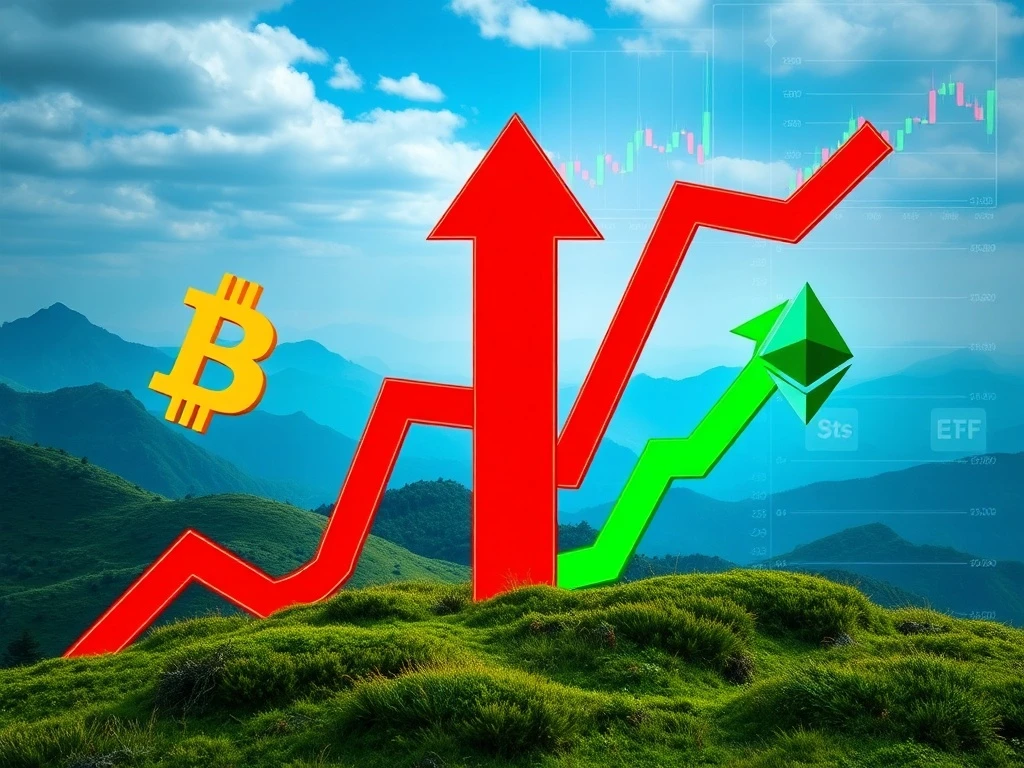Unleashed Potential: Ethereum ETF Surges Amidst Bitcoin Price Dip and $1.18B Market Liquidations

The cryptocurrency world is buzzing with a dramatic shift in momentum, as a recent dip in the Bitcoin price has seemingly paved the way for an extraordinary surge in the Ethereum ETF market. This isn’t just a minor fluctuation; we’re talking about a significant market event that saw over a billion dollars in liquidations, highlighting the volatile yet captivating nature of the digital asset space. If you’re invested in or simply curious about the future of digital finance, understanding these dynamics is crucial.
Bitcoin’s Crossroads: What Sparked the Market Liquidations?
Bitcoin, often seen as the bellwether of the entire crypto market, has been navigating a tense period. Recent data shows the premier cryptocurrency oscillating within a tight $116,000–$120,000 range, holding close to the significant $118,520 psychological threshold. This consolidation phase followed a notable 2.04% decline over 24 hours, bringing its price down to $116,000 on July 26, 2025. What’s even more striking is the context: this price action occurred amidst a staggering $1.18 billion in liquidations just the day prior.
So, what exactly are market liquidations? In the simplest terms, liquidations occur when a trader’s leveraged position is forcibly closed by an exchange due to a sudden and significant price movement against their trade. For instance, if you’re long (betting on price increase) with leverage and the price drops sharply, your position might be liquidated to prevent further losses to the exchange. A $1.18 billion liquidation event signals massive market volatility and a significant number of leveraged positions being wiped out, often leading to cascading price effects.
While Bitcoin’s dominance has slightly softened, falling from peak levels of 66% to around 60%, its stability—or lack thereof—still provides the foundational backdrop for the broader market. Key support levels at $115,000 and $112,500 are now under intense scrutiny. A breach of these levels could trigger broader market apprehension and potentially lead to further downturns, impacting everything from stablecoins to emerging altcoins.
The Unprecedented Rise of the Ethereum ETF
Amidst Bitcoin’s fluctuations, Ethereum has undeniably stepped into the spotlight, showcasing remarkable resilience and attracting immense institutional interest. The second-largest cryptocurrency has been steadily approaching the $3,800 mark, fueled by a surge in demand from institutional players.
A prime example of this burgeoning interest is BlackRock’s iShares Ethereum Trust (ETHA). This Ethereum ETF has achieved an astounding feat, accumulating $10 billion in assets under management (AUM) within just 251 days of its inception. Even more impressive, a significant portion of this growth—$5 billion—was amassed in a mere 10 days! This rapid accumulation underscores a growing appetite among traditional investors for regulated exposure to Ethereum, reflecting increasing confidence in its long-term potential.
This institutional embrace is largely bolstered by the evolving U.S. regulatory landscape, which is gradually providing more clarity for digital assets. Furthermore, Ethereum’s ecosystem continues to solidify its role as a hub for decentralized activity. Its Total Value Locked (TVL) stands at a robust $80.958 billion, representing a dominant 59.65% of the entire decentralized finance (DeFi) market. This immense TVL signifies the vast amount of capital locked within Ethereum’s smart contracts, powering everything from lending protocols to decentralized exchanges.
However, it’s not all smooth sailing. The Ethereum validator exit queue has reportedly exceeded 680,000 ETH. This indicates that a significant number of stakers are reevaluating their strategies, potentially withdrawing their staked ETH. While this doesn’t necessarily signal a bearish outlook, it’s a metric worth monitoring as it could reflect shifts in investor sentiment or a desire for greater liquidity.
Decoding Altcoin Activity: ETHBTC and Beyond
The interplay between Bitcoin’s performance and the broader altcoin activity is often best observed through the ETHBTC pair. This pair, which measures Ethereum’s value against Bitcoin, remains a pivotal metric for altcoin traders. Currently trading near 0.031 BTC, it has faced resistance in breaking above 0.033 BTC. This dynamic highlights a crucial balance: while Ethereum demonstrates strong individual momentum, its ability to truly challenge Bitcoin’s dominance often hinges on its performance relative to BTC.
If Ethereum can decisively surpass the $4,000 psychological barrier, it could redefine the market’s risk appetite. Such a move might signal a broader rotation of capital from Bitcoin into altcoins, challenging the long-held notion of Bitcoin’s unquestionable supremacy. This could usher in a new phase of altcoin growth, with Ethereum leading the charge.
Yet, the altcoin market is also home to cautionary tales. For instance, PUMP Coin’s recent struggles—trading below $0.0028 with a $470 million volume but a market cap near $1 billion—serve as a stark reminder of the inherent volatility and speculative nature of some altcoin projects. Similarly, while the Ethereum-based Snorter Token ($SNORT) has seen increased demand, market participants are always advised to approach promotional activity with extreme caution and conduct thorough due diligence.
Regulatory Tailwinds and Future Outlook for the Crypto Market
The broader crypto landscape is also being shaped by significant regulatory developments. The anticipated passage of the stablecoin bill, known as the GENIUS Act, is expected to inject further confidence into Ethereum’s ecosystem. Clearer regulations for stablecoins, which are often built on Ethereum, would provide a more stable and predictable environment for institutional and retail users alike.
This legislative progress, coupled with Ethereum’s robust TVL growth, is likely to fuel increased demand for on-chain trading tools and decentralized applications. As institutional capital continues its relentless flow into the space, the need for sophisticated and compliant infrastructure becomes paramount.
The relationship between ETF inflows and price movements remains a complex one, often described by experts like Bloomberg’s Eric Balchunas as a “chicken or egg question.” Does the price rise because of ETF inflows, or do ETF inflows increase because the price is already rising? Regardless of the causality, the synergy between these factors is undeniable and continues to drive the market forward.
While some analysts project a potential $300,000 target for Bitcoin by year-end, it’s crucial to remember that such forecasts remain speculative and are not currently reflected in the immediate Bitcoin price action. The future of the crypto market will depend on a confluence of factors: continued institutional adoption, regulatory clarity, technological advancements within networks like Ethereum, and the ever-present dynamics of supply and demand.
Conclusion: A Dynamic Shift Underway
The recent market movements, characterized by Bitcoin’s modest dip and the explosive growth of the Ethereum ETF, paint a vivid picture of a rapidly evolving digital asset landscape. The $1.18 billion in market liquidations serves as a potent reminder of the inherent risks, yet the surging institutional interest in Ethereum highlights the immense potential for growth and maturation. As regulatory frameworks solidify and altcoin activity continues to diversify, the interplay between these major forces will define the next chapter of the crypto market. Staying informed and understanding these complex dynamics will be key for anyone navigating this thrilling frontier.
Frequently Asked Questions (FAQs)
Q1: What caused the $1.18 billion in market liquidations?
The $1.18 billion in liquidations occurred primarily due to a 2.04% 24-hour decline in Bitcoin’s price. This sharp drop triggered forced closures of highly leveraged trading positions that were betting on higher prices, leading to a cascade of sell-offs.
Q2: How significant is BlackRock’s $10 billion Ethereum ETF (ETHA) accumulation?
BlackRock’s iShares Ethereum Trust (ETHA) accumulating $10 billion in assets within 251 days, with $5 billion of that in just 10 days, is highly significant. It demonstrates robust institutional demand for regulated Ethereum exposure and signals growing mainstream acceptance and confidence in Ethereum as an investable asset.
Q3: What does Bitcoin’s softened dominance mean for the crypto market?
Bitcoin’s softened dominance (from 66% to 60%) suggests that altcoins, particularly Ethereum, are gaining market share and becoming more independent in their price movements. While Bitcoin still influences the market, a lower dominance indicates a more diversified and potentially mature crypto ecosystem where other assets play a larger role.
Q4: What is the significance of Ethereum’s Total Value Locked (TVL)?
Ethereum’s TVL of $80.958 billion, representing nearly 60% of the DeFi market, signifies the vast amount of capital locked within its decentralized applications and protocols. A high TVL indicates strong utility, developer activity, and user adoption, solidifying Ethereum’s position as a leading platform for decentralized finance.
Q5: How do regulatory developments, like the GENIUS Act, impact Ethereum?
Regulatory developments such as the GENIUS Act (stablecoin bill) are crucial for Ethereum. Clear regulations provide legal certainty for businesses and investors, reduce risks, and encourage greater institutional participation. This fosters a more stable and trustworthy environment, likely increasing demand for Ethereum-based applications and services.
Q6: What does the Ethereum validator exit queue signify?
The Ethereum validator exit queue exceeding 680,000 ETH indicates that a significant number of stakers are choosing to unstake their ETH. This could be for various reasons, including rebalancing portfolios, seeking liquidity, or reacting to perceived changes in staking profitability or market conditions. While it’s a metric to watch, it doesn’t necessarily imply a negative outlook but rather a dynamic adjustment by investors.










